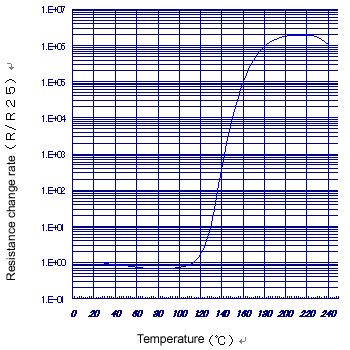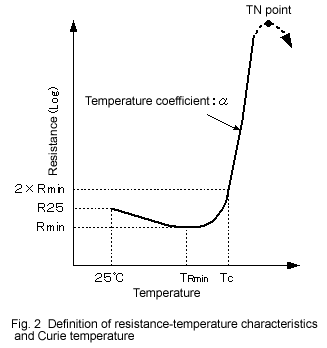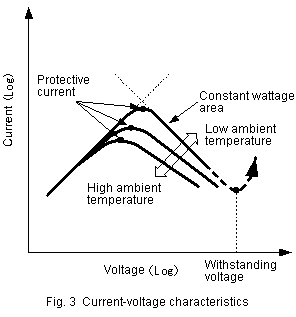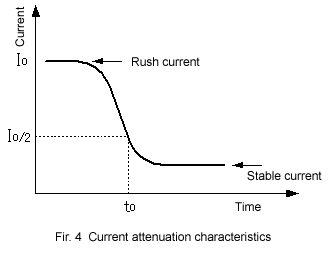Technical information of PTC thermistors
1.Resistance-temperature characteristics
Fig. 1 shows resistance-temperature characteristics obtained when electrical current is measured with a small voltage which is so low as not cause self-heat dissipation due to Joule heat development(typically 1.5V DC). In this instance, the ambient temperature of a PTC thermistor is to be changed.
Generally, PTC thermistors exhibit substantially stable or slightly declining resistance-temperature characteristics in the vicinity of normal temperature, and, starting at a certain temperature, resistance will rise steeply.The point where resistance sharply rises is called Curie temperature(Tc).

2.Curie temperature(Tc)
Curie temperature(Tc)is defined to be the temperature at which resistance becomes twice the minimum resistance(Rmin) as shown in Fig.2.

3.Temperature coefficient
PTC thermistors’resistance steeply rises in an area where temperature exceeds the Curie temperature, as shown in Fig. 2.The gradient of this increase in resistance due to temperature is called temperature coefficientαwhich can be obtained by the following formula:

4.Current-voltage characteristics
As voltage goes up from the low voltage side as shown inFig. 3,current rises just about linearly along the constant resistance line while thermal equilibrium is reached at every voltage.
This is attributable to the fact that PTC thermistors function as a constant resistor because self-heat dissipation is small in a low voltage area.
PTC thermistors will rise, and current will drop nearly linearly along the constant dissipation line after hitting the maximum current point.
A change reactive to the ambient temperature change will occur.

5.Protective current
The maximum current point as shown in Fig. 3 represents the point through which the maximum current can flow statically through a PTC thermistor and is also called a protective current.
6.Withstanding voltage
characteristic exists near the TN point in Fig. 2, continued application of higher voltages will reduce resistance of PTC thermistors beyond the TN point and they will finally result in a voltage breakdown.
Further rise of the voltage beyond the constant wattage area in Fig. 3 will cause the minimum current point to be reached. Then, an area where the current will abruptly and sharply increase will be entered if the voltage is kept rising.
Despite the fact that the point of stability of PTC thermistors’resistance-temperature
This voltage is called withstanding voltage. Thermistors’ rated voltage is defined with the voltage nearing the TN point as the base voltage, plus a safety margin determined with their reliability taken into account.
7.Current attenuation characteristic
Application of voltages, the resulting current from which will be lower than the protective current(the maximum current at which PTC thermistors’ operation will be static), will not change the current regardless of the elapse of time.
However, right after application of a current larger than the protective current to PTC thermistors, a large current will flow, followed by a rapid decline in the current, as the current attenuation characteristic shown in Fig 4.

8.Operating time
Operating time is defined to be the period of time covering start of application of a voltage to PTC thermistors until the current attenuates.It is generally the time needed for rush current(IO)to decay to 1/2.
9.Stable current
Stable current is defined to be the current steadily flowing through PTC thermistors when a voltage is applied to them and their temperatures are stable.
In general, the higher Zero-power of PTC thermistors and the higher the applied voltage, the smaller stable current.
10.Recovery time
PTC thermistors are to be supplied with a self-heating voltage to become highly resistive. Then, remove the voltage application. Recovery time is defined to be the period of time during which resistance grows to twice the Zero-power of that at removal of the voltage.
